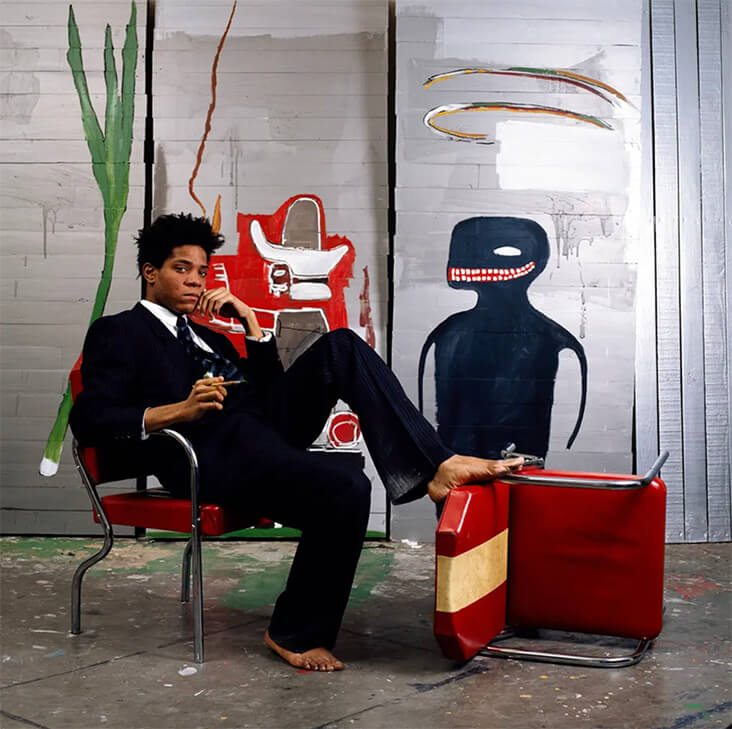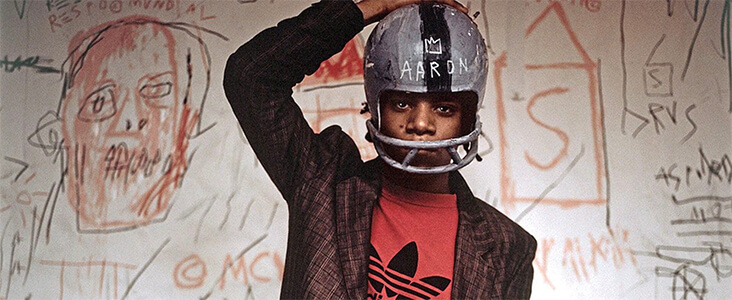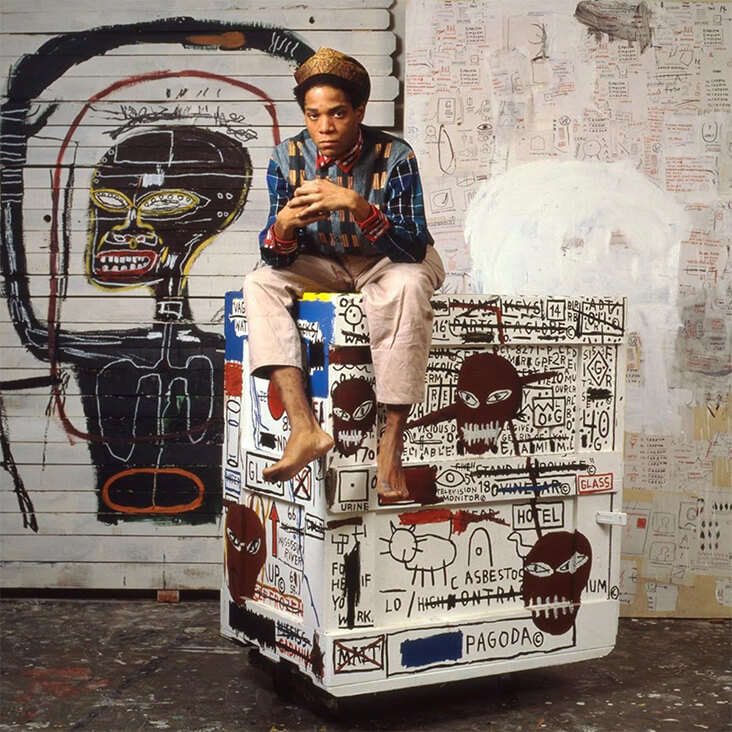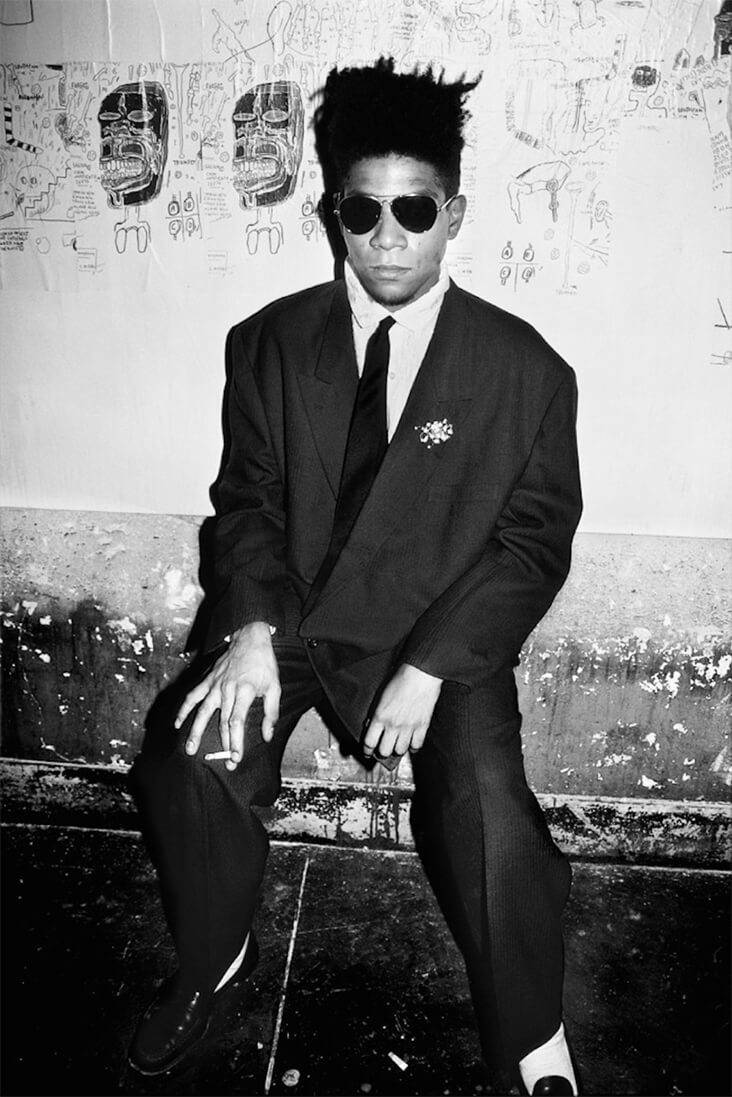Post-Punk Irreverence: Jean Michel Basquiat’s Fabric
American painter Jean-Michel Basquiat came of age in 1980s New York, a time when the worlds of art, fashion, music and celebrity were colliding into one. Much like his contemporaries and friends Andy Warhol and David Bowie, Basquiat brandished a public image that was as quirky, distinctive and irreverent as his art. Loose Armani suits splattered with paint were worn with crumpled shirts and bare feet or trainers, a mish-mash, bricolage approach to dressing that reflected the artist’s post-punk attitude to art and life. He loved clothes, and the way they could allow him to express the complexity of his identity. Giorgio Armani observed how, “he had a very unique look – he had hair as distinctive as Warhol’s and wore suits in a way as stylish and relaxed as Bowie.”
Born in Brooklyn, from a young age Basquiat became aware of the impact a distinctive self-image could have. His mother would often design and make clothes for him, while one teacher noted how he would stick pencils in his hair to make it stand out. Despite dropping out of high school and struggling with periods of homelessness, the young Basquiat was industrious and creative, finding a voice through New York City’s underground graffiti scene under the pseudonym SAMO.

Jean-Michel Basquiat wearing Giorgio Armani, seating in front of his work. Photograph: Lizzie Himmel/AP/Brooklyn Museum
Before making his name as an artist, Basquiat found early success with a series of hand-painted clothes under the label ‘Man Made.’ Using items of clothing found on the street, including sweatshirts, lab coats and jumpsuits, Basquiat upcycled them with hand-drawn scrawls of imagery and text, including his trademark crown, a recurring emblem of his graffiti art. One of the first to recognise the artist’s distinctive voice was costume designer Patricia Field, who agreed to sell his line in her East Village Boutique in 1979. Fields also gave Basquiat free reign to display his artworks in her store windows. Though Basquiat would later replace clothing with canvases, and shop windows with art galleries, his first taste of exposure came through the world of fashion, setting a precedent for the future.
Throughout the 1980s Basquiat made a name for himself as an anarchic, rebellious artist, creating punky, neo-expressionist paintings filled with raw energy and angst. Much like his contemporaries in the New York art scene, Basquiat quickly recognised how important a distinctive self-image could be, but there is also a sense that he found freedom through his own distinctive style, asserting his voice in an oversaturated age of media and celebrity.
Basquiat pioneered an eclectic high-low approach to fashion, combining smart tailoring with streetwear, punky hair and bare feet. Designer shirts were worn un-ironed, ties loosened and jackets slung low on the shoulders. He famously claimed he made all his paintings while wearing Armani suits, leaving them splattered with oil paint, an act Giorgio Armani adored for its cheeky irreverence, commenting with pleasure, “I design clothes to be worn, for people to live in!”
As Basquiat’s fame as an artist grew, his distinctive image took on an iconic status, as popular and instantly recognisable as his great friend and mentor Andy Warhol. Basquiat subsequently appeared in high profile fashion and magazine shoots, catwalk shows and music videos. All this happened before Basquiat suddenly and tragically passed away at the age of 27, at the peak of his fame. Since then, Basquiat has continued to cast a long shadow in the world of contemporary fashion, with menswear designers returning again and again to his look book for inspiration. His estate recently collaborated with Reebok and Supreme on a range of sportswear, while designers Marni and David Nieper have made nods towards his laid back, nonchalant tailoring and loose graffiti motifs. Robert Johnston, style director at British GQ called Basquiat’s image “a work of art in itself”, because it expressed intimately how Basquiat really wanted to be seen, and remembered for all time.













































3 Comments
Rae Ferguson
At the age of 8 years, Basquiat was injured in a vehicular accident requiring surgery. During his convalescence, his mother gave the textbook Gray’s Anatomy to him, which ABSORBED his young mind. One can appreciate from his vast body of work, this obsession with the body’s Anatomy. Just an observation, but judging a book by its cover is not always apropos.
Alberta Davidson
Irreverent?
Tortured splayed bodies.
Death cult graffiti.
Elo Valdez
There is a thin line between genius and insanity. Tortured soul, indeed.